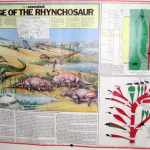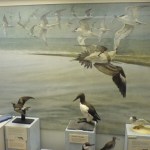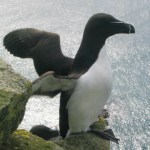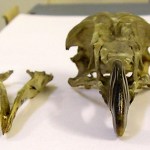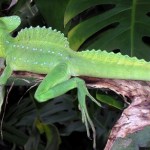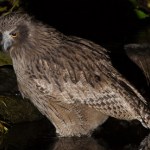
'... [it] clambers up and down trees because it cannot fly ... it purrs like a cat and smell like a posy of fragrant flowers ... it allows itself to be picked up and handled without demur or apparent concern' (Vietmeyer 1992, p. 69).
Another Ten Bird Meme bird (use the search bar if you need more information on that concept). Sometimes called the Owl parrot, the Kakapo Strigops habroptilis was first described by John Gray in 1845 [adjacent image is John Keulemans's painting of 1873]. Everything about the Kakapo is extraordinary. It's a large, nocturnal, cryptically-coloured, terrestrial…
Last year Dave Hone (of Archosaurs Musings) and Mike Benton published their analysis of the English rhynchosaur Fodonyx spenceri. Ever one to make promises that I'm unable to fulfil (in the short term, at least), I vowed to cover the group at some stage. Neil Kelley recently reminded us that 2008 was the year in which the blogosphere began to reflect the global Scientific Triassicism movement. Here was the biblical sign I needed to dust off my files and, goddammit, publish on those rhynchosaurs.
Also spurring me into action was the fact that I had to put my much-loved 'The Age of the…
Over the weekend Will and I visited another local museum: this time Westbury Manor Museum, Fareham (Hampshire, England). I particularly liked the several bird paintings they have on display, one of which - the one you can see here - was duplicated and enlarged and used as the back-drop to a case of stuffed local birds.
Despite strenuous efforts I've failed to find out who the artist was: the website gives no information, and if there was labelling I somehow missed it. It's not Charles Tunnicliffe by the way [UPDATE (added January 2010): the artist is Dan Powell. See comment 12 below].…
The mystery skull from the other day is indeed that of a charadriiform: more specifically that of an auk and, most specifically of all, that of a Razorbill Alca torda. Well done Dartian and Kryptos18, and well done everyone else for trying. I admit that I deliberately showed the skull in 'front view' (rostral or anterior view) because this made things more difficult. Furthermore, I was hoping that at least some people might make the fairly obvious mistake of identifying the skull as that of a dodo or raptor. Had you not recognised the skull immediately, here's how you might have identified…
Test your skills and impress us all by identifying the object! Dammit, missed Atomic Betty...
I don't know about the rest of the world, but in Britain there is a very entrenched tradition of 'feeding the ducks'. People go on walks (usually at the weekend), and they take with them bagfuls of bread (sometimes even whole loaves). They then proceed to throw all the bread in the water. After a while the ducks and other birds at the pond get bored or full, and they stop eating it (see photo, taken over the weekend at Southampton Common's Cemetary Lake). Then more people come and throw in more bread. More people come, and they throw in more bread. Then more, and so on and on. On any given…
It's very funny how things sometimes work out. I had absolutely no plans whatsoever to cover cats at Tet Zoo this week. Then, on Friday, I watched the documentary that featured the pogeyan* and, obviously, decided that it was worth covering. And, during the County Museum visit on Saturday, my encounter with the Hayling Island Jungle cat was totally fortuitous: I'd forgotten that it was there, and probably would have missed it were it not for the fact that Chris Palmer got it out of its cabinet. Yesterday, I received some very interesting photos from Ryan Norris at the University of Vermont.…
Oh my god. Two years at ScienceBlogs have passed, and Tet Zoo has now been going for three years. It all started on January 21st 2006 when, for no good reason at all, I started a blog over at blogspot.com. Yes, Tet Zoo is three years old. Time to look back at the past year of operation.
For starters, should you want to know more about Tet Zoo's origin and history of operation, read Happy first birthday Tetrapod Zoology part I and part II (both at ver 1), and Happy second birthday part I and part II. Last year, I included a 'what happened in tetrapods during 2007'. I'm not going to do the…
Over the weekend I and a bunch of others from the Southampton Natural History Society visited the collections at the County Museum, Winchester (Hampshire, UK). This is a research collection and local repository, and is not open to the public. We saw tons of stuff and had a great time. I took Will (my 7-year-old) along, and he loved it, spending literally hours looking through drawers of pinned insects and at stuffed things in cases. I see every indication that kids are naturally fascinated by animals and other living things: it's just that this interest is often not switched on at the right…
I've pretty much given up on TV. I occasionally watch a few things (The IT Crowd, Doctor Who, QI, Never Mind the Buzzcocks), but mostly it's all shit and I'd be very happy to not have a TV at all. Once in a blue moon, however, there is something really good. On Friday evening (Jan 16th), BBC 2 screened 'The Mountains of the Monsoon' as part of its The Natural World series. This featured wildlife photographer and environmentalist Sandesh Kadur as he travelled about the Western Ghats in quest of wildlife.
The Western Ghats evidently has some awesome wildlife. There are dholes, tigers,…
There just haven't been enough squamates around here lately (well, apart from the anguids). Because I have guilt, here is a good photo of a beautiful animal: a Plumed basilisk Basiliscus plumifrons. Thanks to their striking appearance, basilisks are often featured in books and on TV, but people only ever say the same two things about them: (1) that they have striking display structures like those so obvious here, and (2) that they can run (bipedally) across the surface of water. Yeah yeah, I've heard all that before - tell me something new, puh-lease!
I have to admit that I can't: all the…
Most people who know stuff about animals 'know' that the White rhino Ceratotherium simum owes its vernacular name - not to its colour - but to its wide, flattened lips. After all, the 'White' rhino is not really any whiter than any other rhino. So, the 'white' must - so everyone has been saying - be a corruption of 'wijde', the Dutch for 'wide'. That way, the rhino's name would have started out as Dutch for 'wide-lipped rhino', and that makes sense, right? As it happens, and as rhino expert Kees Rookmaaker of the IUCN's Rhino Resource Center argued in 2003, this explanation just doesn't work…
By popular request, in this and in a few later articles I'll be reposting the rest of the Ten Bird Meme text originally posted at Tet Zoo ver 1 in 2006 (where appropriate, I've added corrections and updates). The 'Ten Bird' birds I've covered so far are Ifrita, Shoebill, Tibetan ground-pecker, and Flying steamer duck. And here we continue with... Blakiston's fish owl Bubo blakistoni [images from here].
If you think evolutionary convergences are cool, then you'll love reversals. Morphological features or aspects of behaviour that have been modified during the evolution of a lineage don't have…
Do you remember that weird old Brontornis picture we looked at back in June? Here it is again...
We're not, on this occasion, interested in the Brontornis, but instead in the freaky long-necked duck-billed monster that's menacing it.. or, that it's menacing (impossible to say). That creature - and, from hereon, that's what I'll call it - is some sort of hypothetical composite. If the artist was trying to depict a hadrosaur, or a plesiosaur, then (to put it mildly) they appear not to have been too worried about accuracy. Anyway, the important thing is that you look at its head. Moving on: do…
Last year the blogosphere and global media went nuts over the 'Montauk monster'. A small mammal corpse that washed up on the beach at Long Island, New York, it was not an alien, government experiment, or sea-monster, as widely claimed by idiots worldwide, but - without doubt - a dead, rotten raccoon. This month a vaguely similar sort of thing is happening, though this time there is less hype. And, for me, the corpse is closer to home, having been discovered on Croyde Beach in Devon, southern England [its skull is shown at left]. The Croyde carcass made several national newspapers, including…
Here we are, at the beginning of 2009. And here's where I get that horrible feeling that - on the 'things to do for 2008' list - so many things remain incomplete. Among these are a number of Tet Zoo posts that were cutting-edge and topical when I started them, yet are now not so cutting-edge, and not so topical. Whatever: here's a brief article I'd planned to publish months ago. It concerns the Bulo Burti boubou Laniarius liberatus, a bush-shrike described in 1991 on the basis of a single individual captured in central Somalia (Smith et al. 1991) [adjacent photo © E. F. G. Smith]. Bush-…
It's not everyday that you discover a shop named after a group of fairly obscure amphibious lipotyphlans. While in Spain last year, I was intrigued by this shop...
I think it sold clothes or something, though frankly I don't recall checking. Here's a close-up of the animal featured on the signage...
Desmans are members of Talpidae (the same group that includes the moles), and there are only two extant species: the Russian desman Desmana moschata and Pyrenean desman Galemys pyrenaicus (there are loads of fossil species though, in about ten extinct genera). Both have a long, sensitive…
At the start of 2008 I promised myself - in fact, I might even have said it on Tet Zoo - that I'd photograph all the Slow-worms Anguis fragilis I see. The bad news is that I only saw four and - of those - one was dead. Nevertheless...
Both individuals you see here (above) were found in the New Forest, within sight of Bournemouth Airport. Neither are fully adult. The male on the left is doing a nice job of coiling round my thumb, and he's showing his grey belly scales in the process. Like other anguid lizards, slow-worms have relatively small belly scales: very different from the transversely…
Extant sulids - the gannets and boobies - are admittedly pretty uniform (greater diversity existed among fossil forms, as we'll see at some stage), but they still differ in many subtle ways. In the previous sulid post we looked at the gannets: we now turn to the boobies [composite image shown here features Blue-footed booby at top left, Brown booby at bottom left, and Nazca booby at right. All pics from wikipedia].
If you're here because you hadn't realised that 'boobies' was being used in the ornithological sense, sorry. On that subject - everyone knows why the birds are called 'boobies'.…
Late last year (on December 22nd) the British newspapers told the story of Pete, a purple-coated Grey squirrel Sciurus carolinensis photographed in the grounds of Meoncross School, Stubbington (Hampshire, UK). Why a Grey squirrel should have a purple coat is, of course, the big mystery.
One suggestion is that Pete might have found purple ink cartridges in the bin and somehow groomed the ink into his fur. I suppose that's possible, but it sounds pretty unlikely. Local naturalist Chris Packham has been quoted as suggesting that Pete fell into a bucket 'containing a weak colour solution'.…

